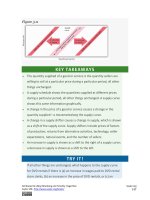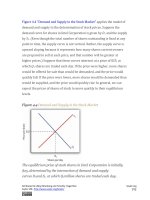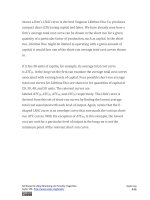Authors libby rittenberg 152
Bạn đang xem bản rút gọn của tài liệu. Xem và tải ngay bản đầy đủ của tài liệu tại đây (445.49 KB, 1 trang )
4. Explain how the circular flow model provides an overview of demand
and supply in product and factor markets and how the model suggests
ways in which these markets are linked.
In this section we combine the demand and supply curves we have just
studied into a new model. The model of demand and supply uses
demand and supply curves to explain the determination of price and
quantity in a market.
The Determination of Price and Quantity
The logic of the model of demand and supply is simple. The demand curve
shows the quantities of a particular good or service that buyers will be
willing and able to purchase at each price during a specified period. The
supply curve shows the quantities that sellers will offer for sale at each
price during that same period. By putting the two curves together, we
should be able to find a price at which the quantity buyers are willing and
able to purchase equals the quantity sellers will offer for sale.
Figure 3.14 "The Determination of Equilibrium Price and
Quantity" combines the demand and supply data introduced in Figure 3.1
"A Demand Schedule and a Demand Curve" and Figure 3.8 "A Supply
Schedule and a Supply Curve" Notice that the two curves intersect at a
price of $6 per pound—at this price the quantities demanded and supplied
are equal. Buyers want to purchase, and sellers are willing to offer for sale,
25 million pounds of coffee per month. The market for coffee is in
equilibrium. Unless the demand or supply curve shifts, there will be no
tendency for price to change. The equilibrium price in any market is the
price at which quantity demanded equals quantity supplied. The
equilibrium price in the market for coffee is thus $6 per pound.
Attributed to Libby Rittenberg and Timothy Tregarthen
Saylor URL: />
Saylor.org
152









